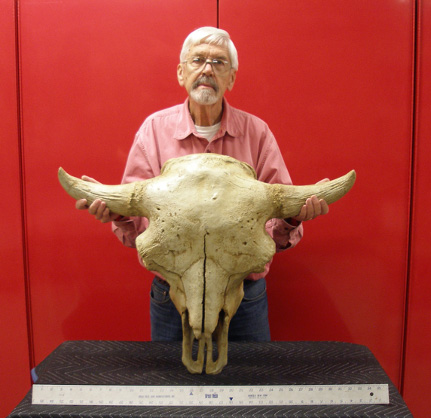
CMC Blog
Prehistoric Bison
By: Glenn W. Storrs, Ph.D., Withrow Farny Curator of Vertebrate Paleontology
Two prehistoric bison species became known to science when their fossils were discovered in Boone County, Kentucky, home of the Cincinnati/Northern Kentucky International Airport and just down I-71/75 from Cincinnati. The Giant Bison, Bison latifrons, was identified from a skull fragment found around 1800 in the bed of a stream, likely either Gunpowder or Woolper Creek. Numerous additional fossils of the animal have since been discovered in North America, primarily in Florida and the American West. However, a fine set of horn cores was discovered in the late 19th century in Brown County, Ohio, and remains the only record of the animal from our state. Judging from this fossil and others, the distance between the horn tips of the Giant Bison was as great as seven feet, much larger than the two-foot span between the horn tips of the modern American Bison, Bison bison. Overall, the body size of the Giant Bison was 25%-50% greater than that of the American Bison. It lived from about 500,000 years ago to about 20,000 years ago.

Giant Bison skull roof with attached horn cores, found in Brown County, Ohio (Cincinnati Museum Center VP5107).
In 1807, a small portion of a bison cranium with an attached horn core was collected from Boone County’s Big Bone Lick. The fossil, in a museum cabinet of the Philadelphia Academy of Natural Sciences, was in 1852 identified as from a previously unknown species and given the name Bison antiquus, the Ancient Bison. Fossils of this species have been found in much of North America, including tar pits of California’s Rancho La Brea where the animal’s bones are the most abundant large herbivore remains. The horn spread of the Ancient Bison was approximately three feet and the animal was 15%-25% larger than the American Bison. It lived from about 250,000 to around 5,000 years ago, when it apparently gave rise to the American Bison.

Cast of an Ancient Bison skull (stalwart volunteer, Stan Hedeen, performs modeling duties!).
Both the Giant Bison and Ancient Bison may share their ancestry with the extinct Steppe Bison, Bison priscus, that lived from around one million years ago to approximately 10,000 years ago. The tips of its horns were about three feet apart and its body size was slightly bigger than that of the American Bison. Fossils of the Steppe Bison have been found in northern Eurasia (where the species also appears in cave paintings) and in North America south to Mexico, but not as of yet in the Cincinnati area. All of Cincinnati Museum Center’s Steppe Bison specimens were collected in Alaska, where even soft tissue has sometimes been preserved in frozen specimens.

Steppe Bison skull with attached horn cores, found in Alaska (Cincinnati Museum Center VP15284).
Museum Admission
Includes Cincinnati History Museum, Museum of Natural History & Science and The Children's Museum
| Adult: | $22.50 |
| Senior: | $15.50 |
| Child: | $15.50 |
| Member Adult: |
FREE |
| Member Child: |
FREE |
Members receive discounts!
Become a Member today to save on programs, exhibits and films throughout CMC.
Museum Hours
Open Thursday – Monday
10 a.m. to 5 p.m.
Closed Tuesday and Wednesday
Closed Thanksgiving Day and Christmas Day
Member’s-only early entry: Saturdays at 9 a.m.
Customer Service Hours:
Monday – Sunday, 9 a.m. to 5 p.m.


